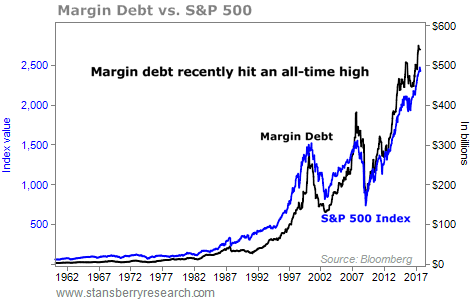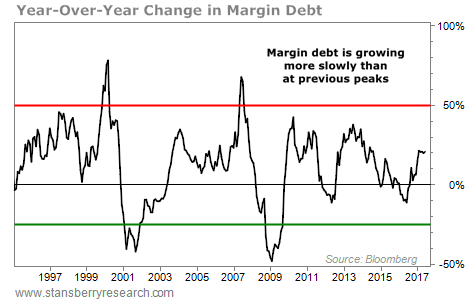| Speculators Are Borrowing More Than Ever... Here's What It Means | | By Dr. Steve Sjuggerud | | Tuesday, August 22, 2017 |
| It's official – investors have borrowed more cash than ever to buy stocks...
We're talking nearly $600 billion borrowed "on margin" – when you add up the margin debt on the New York Stock Exchange (NYSE) and Nasdaq stock markets.
It's more money than investors borrowed at the peak of the dot-com boom in 2000. And more money than the 2007 peak just before the global financial crisis.
That sounds scary, right?
Many "experts" who are looking for a reason for the market to go down might point to it as a sign of the top. But is it something to worry about? Let's take a look...
----------Recommended Links---------
---------------------------------
This chart shows the NYSE's margin debt versus the S&P 500 Index. You can see that we're now at an all-time high... above previous highs when stocks peaked in 2000 and 2007.

At a glance, you might think that the high margin debt could have caused those crashes... or made them worse. But that's not really the case.
Let's look at it another way to see it more clearly...
Here's a chart of the annual change in NYSE margin debt.
You can see that the use of debt to buy stocks spiked right around the market peaks in 2000 and 2007. And it bottomed out two years later.

Those two peaks in the yearly change in margin debt are much better indicators of danger than what you see in the first chart. (And those bottoms in 2001 and 2009 would have been much better buying opportunities.)
That's not quite enough to go on as a trading strategy. But this chart does tell us that we don't need to worry about margin debt (at least not yet). As you can see, today's reading is nowhere near the last two peaks.
Another way to look at total margin debt is relative to the total size of the market.
Margin debt levels have historically fluctuated between 1% and 2% of the overall value of the stock market. Those percentages don't move around much, even though the actual overall margin debt goes up and down.
Right now, while margin debt is at an all-time high, we're still at less than 2% margin on the overall market.
In short, margin debt is high. But by itself, that's no reason to sell U.S. stocks. It's not a sign of danger – yet.
Many investors are scared of the markets right now. They're looking for any excuse to sell. Margin debt will be one of their excuses.
Don't believe 'em. You now know the real story...
Good investing,
Steve
P.S. We're at a crucial point in the Melt Up... where a lot of investors are going to be tempted to do exactly the wrong thing. You have to know the right moves to make. Tomorrow night, I'm hosting a free live event where I'll explain how you can potentially double your money over the next year. Click here to reserve your spot. |
Further Reading:
"Investors are always looking for a reason to NOT invest," Steve writes. This doesn't only apply to charts like today's... It's also true of current events. But most global news is no reason to worry about the markets. Read more here: North Korea Versus the 'Melt Up.' "How you handle the ups and the downs will determine whether you walk away with a fortune or walk away with less money than when you started," Steve says. Learn this simple way to ride your Melt Up winners with limited risk right here: 'We Expect Over 100% Gains per Year.' |
|

MORE LOWS FOR THIS TROUBLED RETAILER
Today's chart highlights the continuing struggles at a top retailer... Apparel and beauty-products supplier L Brands (LB) owns some valuable brands, including Victoria's Secret and Bath & Body Works. But lately, Victoria's Secret has been dragging the company down. And that trend has continued... Last month, sales at Victoria's Secret fell 10% from the same period last year. It was the 11th consecutive month of falling sales at its stores. As you can see below, shares have followed suit. They're down more than 60% from their November 2015 peak and are now trading at a new multiyear low. Until L Brands figures out how to stop the bleeding, stay far, far away... |
| 
| A proven defense contractor that generates strong profits...
Dave Eifrig knows buying quality businesses during a bull market is a winning strategy. And buying this defense contractor is a great way to put that strategy to work...
|
Are You a
New Subscriber?
If you have recently subscribed to a Stansberry Research publication and are unsure about why you are receiving the DailyWealth (or any of our other free e-letters), click here for a full explanation... |
|
Advertisement
A former speechwriter for George H.W. Bush explains. Plus: 6 financial disasters in the making... an interview with Glenn Beck... Wall Street "bounty hunter" Andrew Left... and much more. It's all 100% free in American Consequences. Get the latest issue, right here. |

| 'This Time It's Different' | | By Dr. David Eifrig | | Monday, August 21, 2017 |
| | At the height of the dot-com bubble, tech stocks soared... Bulls argued, "This time it's different." Of course, we know it wasn't.
|
| | A New Type of Crime Will Cause This Industry to Soar | | By Jeff Brown | | Saturday, August 19, 2017 |
| | A new crime wave is sweeping across the country... Unlike crimes of the past, this one can't be stopped with more locks, security cameras, or guards... |
| | Think Stocks Are the Best Long-Term Investment? Think Again | | By Dr. Steve Sjuggerud | | Friday, August 18, 2017 |
| | The conventional wisdom says stocks have historically made for the best long-term investments. But a new academic paper reached a surprising conclusion. |
| | Double Your Odds of Picking a Home-Run Stock | | By Ben Morris | | Thursday, August 17, 2017 |
| Today, we'll dig deeper into why you want to focus your efforts on finding smaller businesses. |
| | Three Keys to Finding Your Next 200%-Plus Winner | | By Ben Morris | | Wednesday, August 16, 2017 |
| | "Building a fortune takes time... But you can safely boost your returns with the occasional, out-of-the-park home run. Let's get started..." |
|
|
|
|

